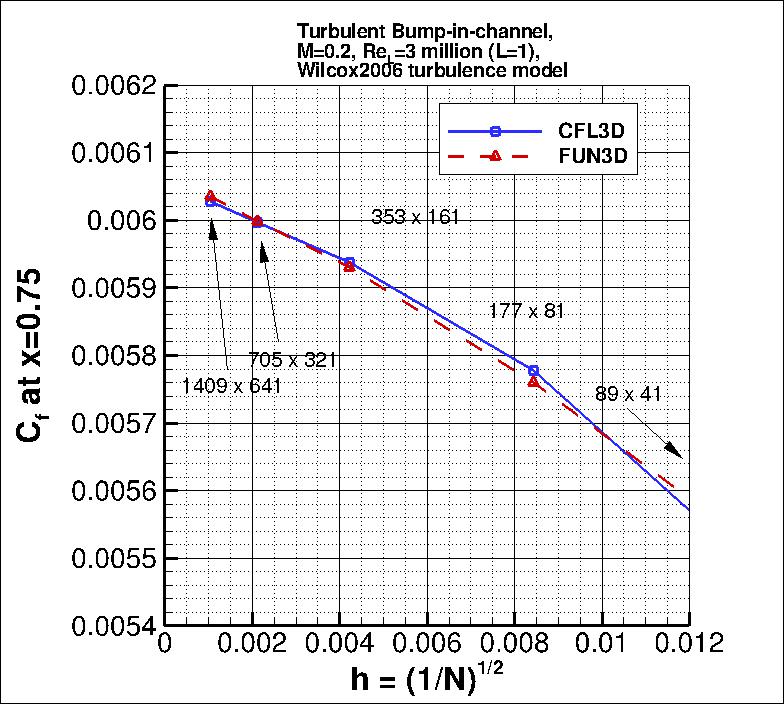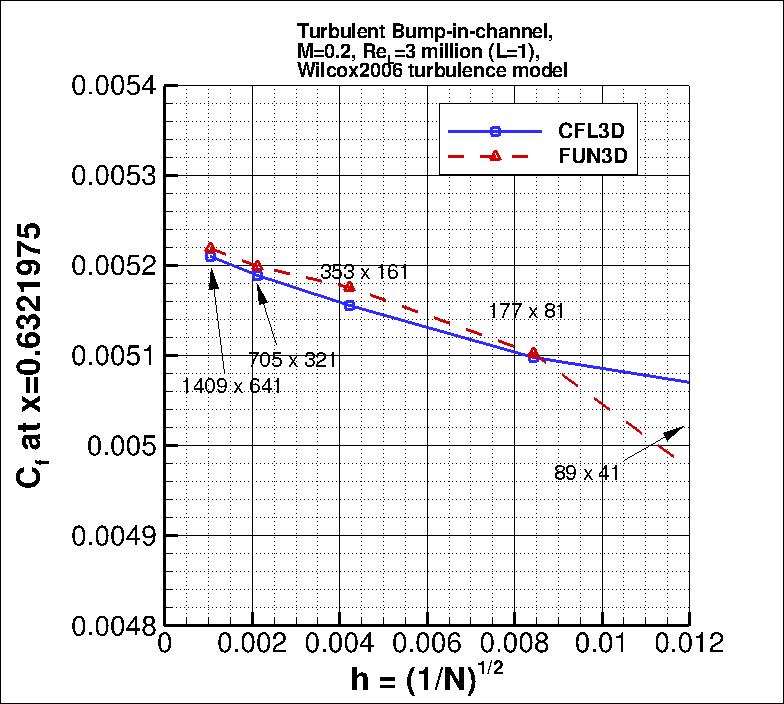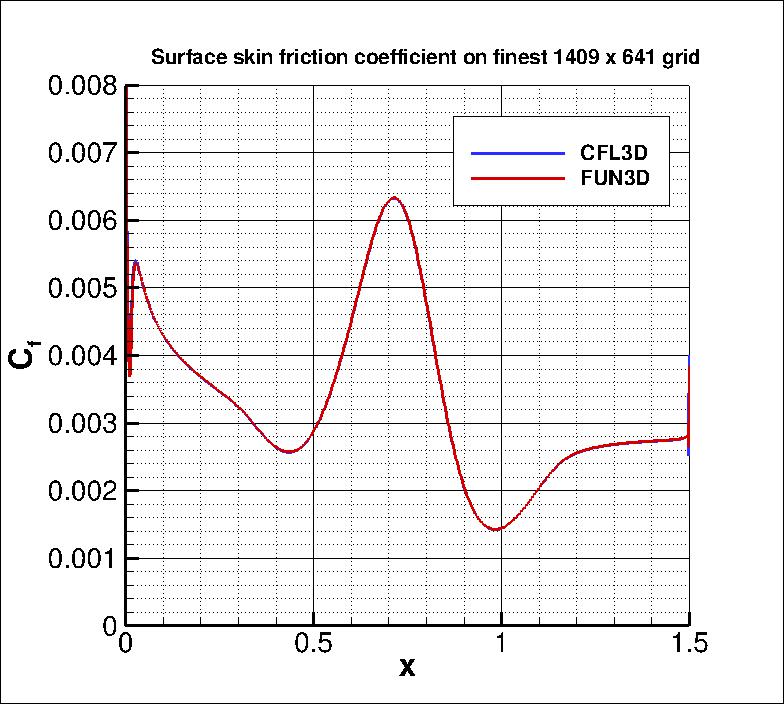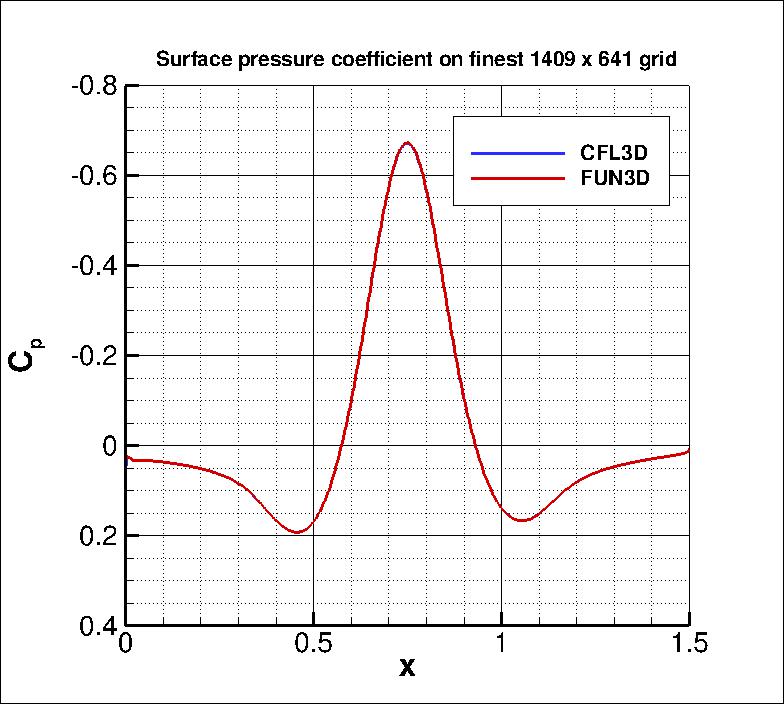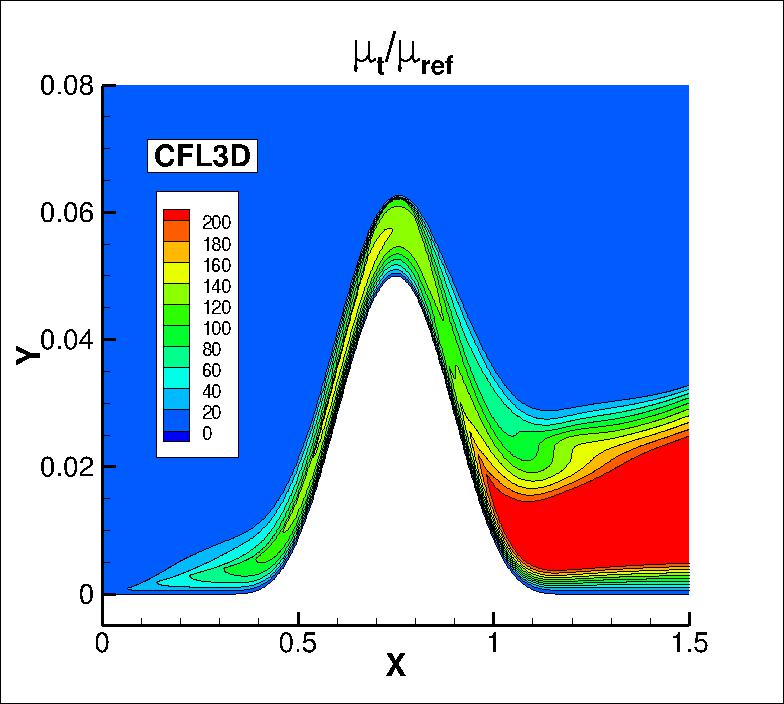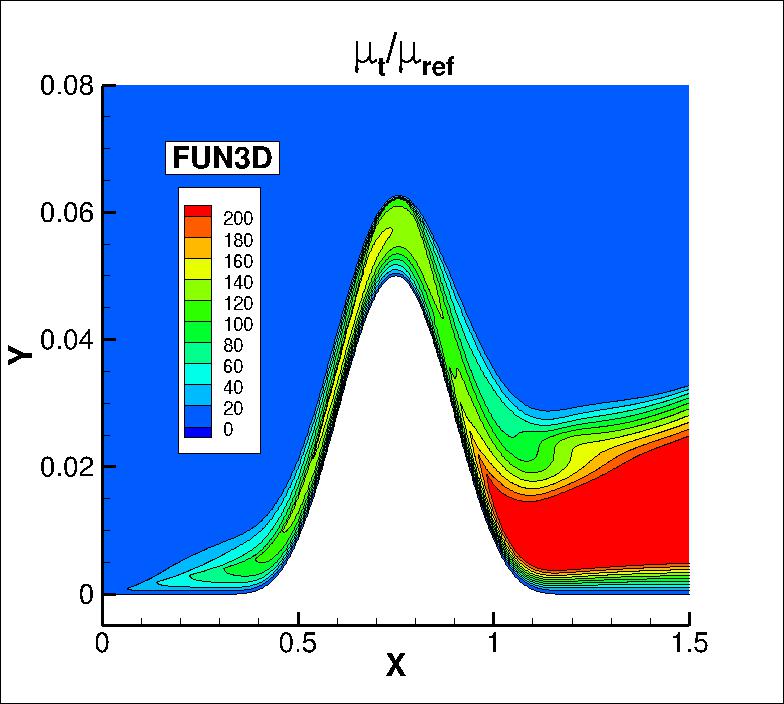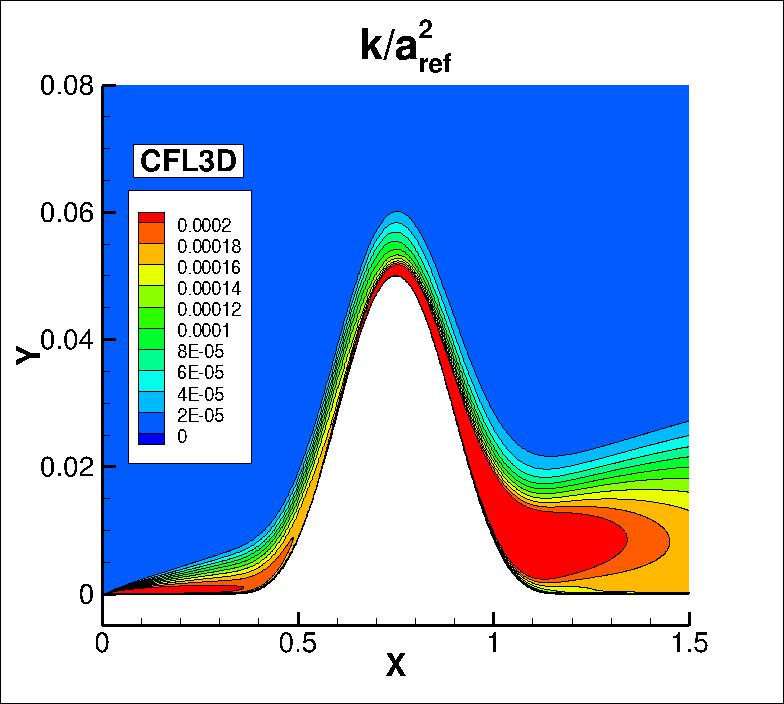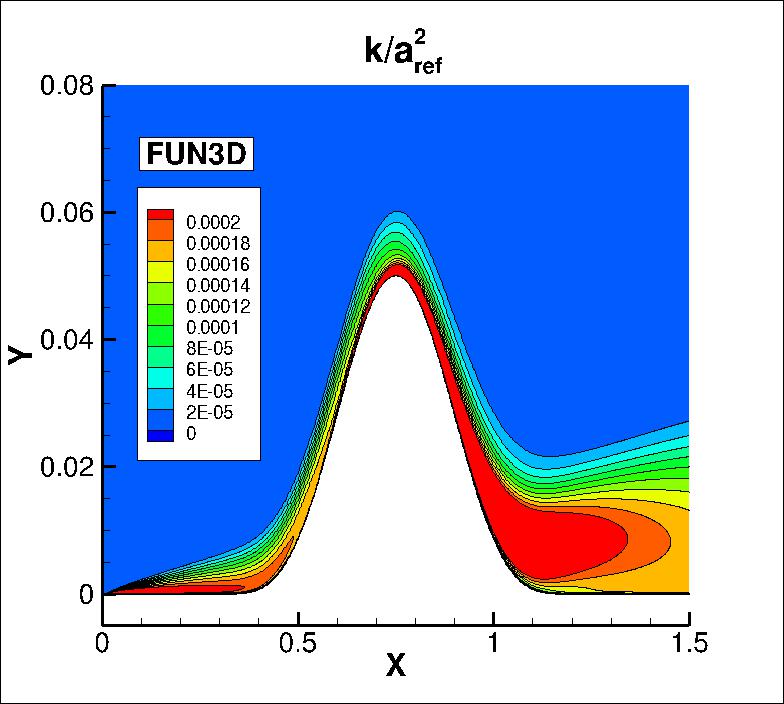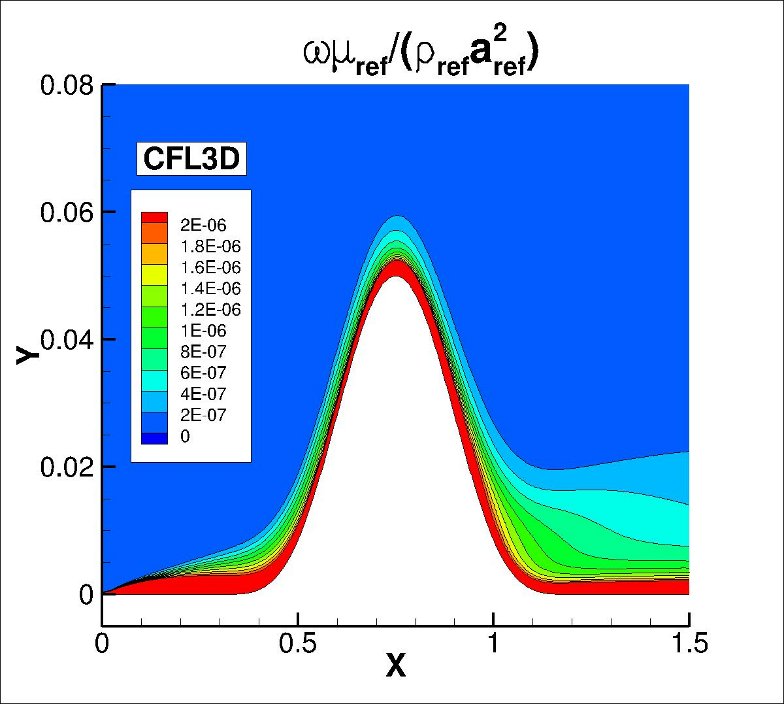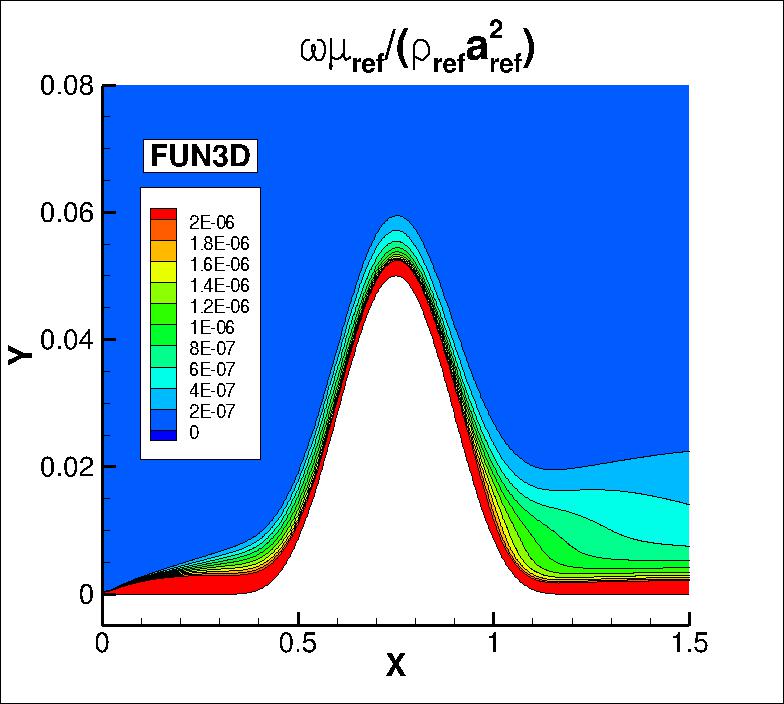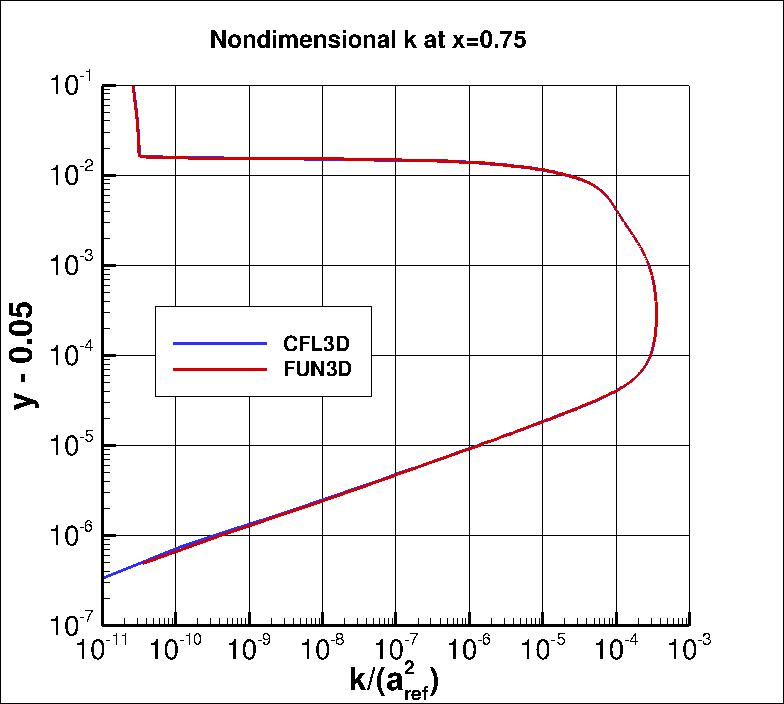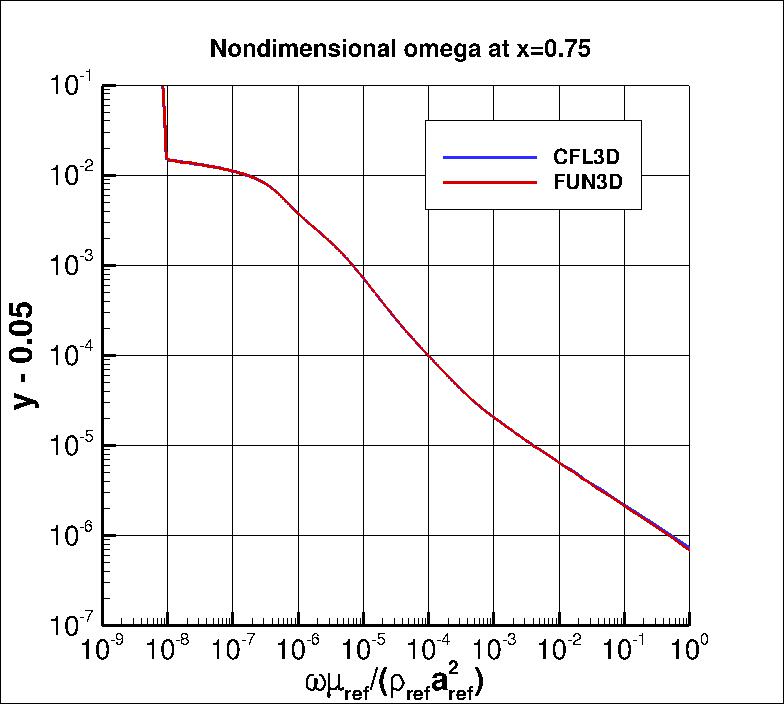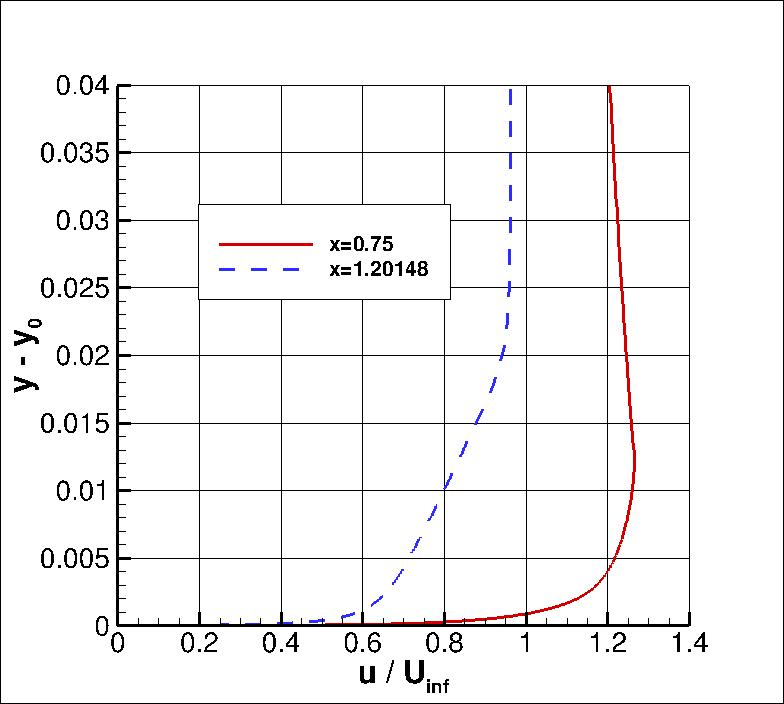Results are shown here from 2 compressible codes
so that the user may compare their own compressible code results. Multiple grids were
used so the user can see trends with grid refinement. Different codes will behave
differently with grid refinement depending on many factors (including code order of accuracy
and other numerics),
but it would be expected that as the grid is refined the results
will tend toward an "infinite grid" solution that is the same.
Be careful when comparing details: any differences in boundary conditions or flow conditions
may affect results.
Two independent compressible RANS codes,
CFL3D and FUN3D, were used to compute this
bump-in-channel flow with the Wilcox2006-klim-m model
(see full description on
Wilcox k-omega page).
The full series of 5 grids were used.
CFL3D is a cell-centered structured-grid code, and FUN3D
is a node-centered unstructured-grid code (FUN3D can solve on mixed element grids, so this case
was computed on the same hexahedral grid used by CFL3D). Both codes used Roe's Flux Difference
Splitting and a UMUSCL upwind approach. In CFL3D its standard UMUSCL (kappa=0.33333) scheme was
used, whereas in FUN3D the option UMUSCL 0.5 was used. Both codes were run with
full Navier-Stokes (as opposed to thin-layer, which is CFL3D's default mode of operation),
and both codes used first-order upwinding for the advective terms of the turbulence model.
Details about the codes can be found on their respective websites,
the links for which are given on this site's
home page.
The codes were not run to machine-zero iterative convergence, but an attempt was made to converge
sufficiently so that results of interest were well within normal engineering tolerance and
plotting accuracy.
It should be kept in mind that many of the files given below
contain computed values directly from the codes,
using a precision greater than the convergence tolerance (i.e., the values
in the files are not necessarily as precise as the number of digits given).
Note that in both CFL3D and FUN3D, the production term

is approximated by

which is exact for incompressible flow. For this particular low-speed flow, the approximation is
very accurate.
(Previously on this page the results were reported as Wilcox2006-klim solutions, but more properly they should be referred
to as Wilcox2006-klim-m because of this approximation and the fact that the
 term is ignored in tau_ij in the momentum and energy equations.)
term is ignored in tau_ij in the momentum and energy equations.)
For the CFL3D and FUN3D tests reported below, the turbulent inflow boundary conditions used for Wilcox2006-klim-m
were the following:


The above two equations represent the "standard" Wilcox2006-klim-m boundary condition
values used by both CFL3D and FUN3D, chosen to achieve
a not-too-low level of freestream
turbulent kinetic energy, a not-too-severe rate of freestream turbulence decay,
and a reasonable level of freestream turbulent eddy viscosity of
 .
.
For the interested reader, typical input files for this problem are given here:
CFL3D V6.6:
FUN3D:
Note that this case was also run with the Wilcox2006m version of the model (no limiter on the k
production term), and results were essentially identical to those shown below.
The following plots show the convergence of the wall skin friction coefficient
at the bump peak (at x=0.75), in front of the bump peak (at x=0.6321975), and
aft of the peak (at x=0.8678025) with
grid size for the two codes.
In the plot the x-axis is plotting 1/N1/2, which is proportional to
grid spacing (h).
At the left of the plot, h=0 represents an infinitely fine grid.
As can be seen, both codes go toward approximately the same result on an infinitely refined grid.
Using the uncertainty estimation procedure from the Fluids Engineering Division of the ASME (Celik, I. B.,
Ghia, U., Roache, P. J., Freitas, C. J., Coleman, H., Raad, P. E.,
"Procedure for Estimation and Reporting of Uncertainty Due
to Discretization in CFD Applications," Journal of Fluids Engineering, Vol. 130, July 2008, 078001, https://doi.org/10.1115/1.2960953), described in Summary of Uncertainty Procedure,
the finest 3 grids yield the following for skin friction coefficient at x=0.75, x=0.6321975, and
x=0.8678025:
| Code |
Computed apparent order, p |
Approx rel fine-grid error, ea21 |
Extrap rel fine-grid error, eext21 |
Fine-grid convergence index, GCIfine21 |
| x=0.75 |
| CFL3D |
1.00 |
0.498% |
0.496% |
0.623% |
| FUN3D |
0.91 |
0.604% |
0.686% |
0.864% |
| x=0.6321975 |
| CFL3D |
0.64 |
0.406% |
0.723% |
0.910% |
| FUN3D |
0.24 |
0.374% |
2.052% |
1.019% |
| x=0.8678025 |
| CFL3D |
0.33 |
0.269% |
1.053% |
0.759% |
| FUN3D |
oscillatory convergence |
0.193% |
N/A |
N/A |
The data file that generated the above plot is given here:
cf_convergence_w06.dat.
The following plots show: (1) total drag coefficient, (2) pressure drag coefficient, (3) viscous
drag coefficient, and (4) total lift coefficient for the bump. In this bump case the surface
skin friction is singular (tends toward infinity) at the leading edge. The finer the grid, the
more nearly singular the local behavior on a finite grid. There is also locally anomalous
behavior in Cf at the back end of the bump wall (at x=1.5), as is often seen in CFD solutions
near trailing edges (see, e.g., Swanson and Turkel, AIAA Paper 87-1107, 1987,
https://doi.org/10.2514/6.1987-1107). Both of these
behaviors may have some influence on the convergence/order-property of the integrated viscous
component of the drag coefficient. As seen in the following plots, both codes are tending
toward similar integrated force coefficient values as the grid is refined. CFL3D is
approaching with oscillatory (non-monotonic) convergence on the finest three grids for total drag and pressure
component of drag, with very litle change on the finest two grids. Convergence is
close to second-order for viscous component of drag, and close to first-order
for lift;
FUN3D is approaching with apparently higher than second-order for pressure component of drag,
near second-order for viscous component of drag and total drag, and near first-order for lift.
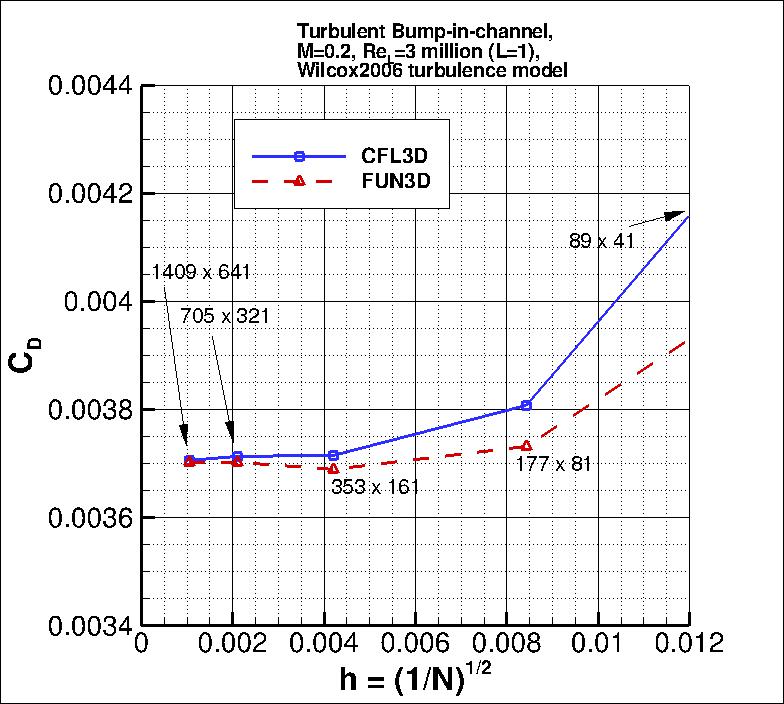
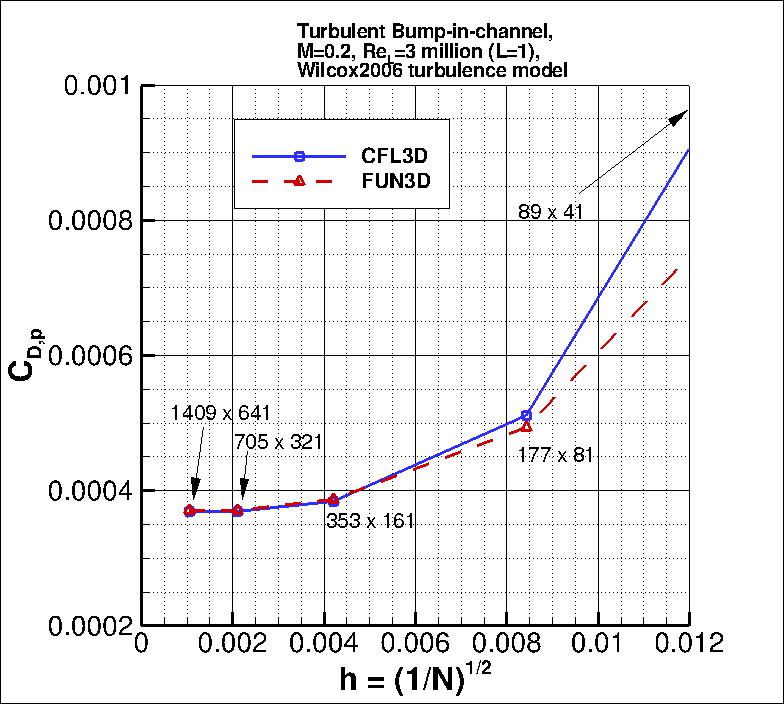

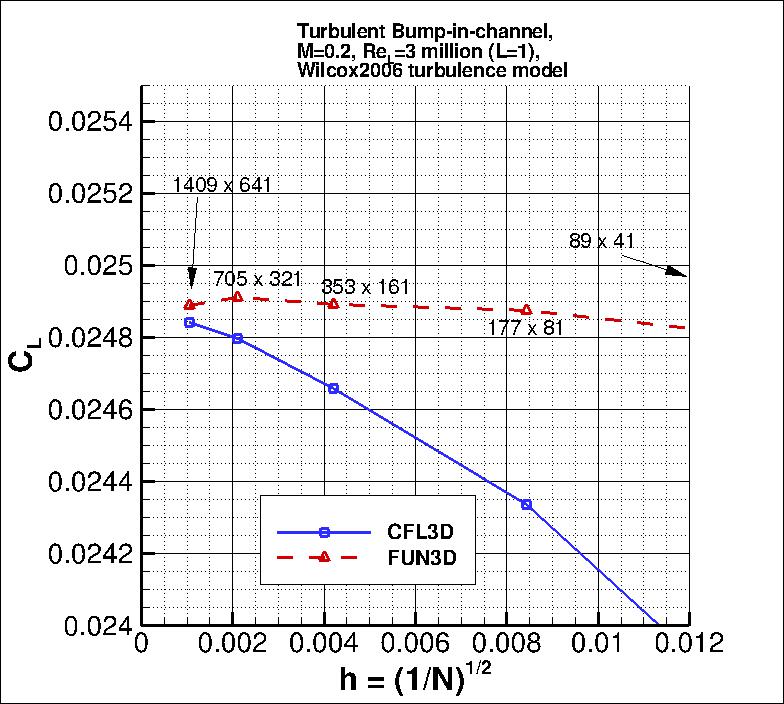
Using the uncertainty estimation procedure from the Fluids Engineering Division of the ASME (Celik, I. B.,
Ghia, U., Roache, P. J., Freitas, C. J., Coleman, H., Raad, P. E.,
"Procedure for Estimation and Reporting of Uncertainty Due
to Discretization in CFD Applications," Journal of Fluids Engineering, Vol. 130, July 2008, 078001, https://doi.org/10.1115/1.2960953), described in Summary of Uncertainty Procedure,
the finest 3 grids yield the following for force coefficients:
| Code |
Quantity |
Computed apparent order, p |
Approx rel fine-grid error, ea21 |
Extrap rel fine-grid error, eext21 |
Fine-grid convergence index, GCIfine21 |
| CFL3D |
Cd |
1.21 |
0.178% |
0.135% |
0.762% |
| CFL3D |
Cd,p |
4.05 |
0.232% |
0.015% |
5.100% |
| CFL3D |
Cd,v |
oscillatory convergence |
0.172% |
N/A |
N/A |
| CFL3D |
CL |
1.62 |
0.182% |
0.088% |
0.109% |
| FUN3D |
Cd |
oscillatory convergence |
0.001% |
N/A |
N/A |
| FUN3D |
Cd,p |
3.55 |
0.343% |
0.032% |
5.463% |
| FUN3D |
Cd,v |
4.49 |
0.037% |
0.002% |
1.077% |
| FUN3D |
CL |
oscillatory convergence |
0.082% |
N/A |
N/A |
The data file that generated the above plot is given here:
force_convergence_w06.dat.
The surface skin friction coefficient from both codes on the finest 1409 x 641 grid
over the entire bump is shown in the next plot. Again, local anomalous behavior exists near the leading
edge (x=0) due to singular behavior of the solution,
and near the trailing edge (x=1.5) due to numerical influences.
These behaviors differ for the two codes, and result in small local deviations that
can be seen when zoomed into the two locations. In addition, both codes indicate turbulence
"activation" at slightly different locations very near the leading edge, 0 < x < 0.02
("activation" is where the turbulence model transitions
on its own from laminar to turbulent). But both codes are seen to yield nearly identical results
over most of the bump wall.
The data file that generated the above plot is given here:
cf_bump_w06.dat.
The surface pressure coefficient from both codes on the finest 1409 x 641 grid
over the entire bump wall is shown in the next plot.
Both codes yield nearly identical results.
The data file that generated the above plot is given here:
cp_bump_w06.dat.
The nondimensionalized eddy viscosity contours, k contours, and omega contours from the two codes on the finest
1409 x 641 grid are shown in the following plots (y-scale expanded for clarity). Results from the two codes on
this grid are essentially indistinguishable.
(Note legends do not necessarily reflect min and max values.)
The CFL3D data files that generated the above plots are given here:
mut_contours_cfl3d_w06.dat.gz (10.1 MB),
k_contours_cfl3d_w06.dat.gz (10.2 MB),
omega_contours_cfl3d_w06.dat.gz (10.2 MB) (structured,
at cell centers). Note that these are all gzipped
Tecplot
formatted files, so you must either have Tecplot or know how to read their format in order to use these
files. (FUN3D files are not given in order to save space.)
Using the finest 1409 x 641 grid, an extracted nondimensional eddy viscosity profile at
x=0.75 is shown below, along with a plot of the maximum nondimensional
eddy viscosity as a function of x.
The data file that generated the eddy viscosity profile at x=0.75 is given here:
mut_0.75_w06.dat.
The nondimensional k and omega profiles at x=0.75 from the 1409 x 641 grid are shown in the following plots.
Note that the sharp behavior of these variables near the boundary layer edge
is one of the characteristics of this model (as well as others - see, e.g., Hellsten, A., "New Two-Equation
Turbulence Model for Aerodynamic Applications," PhD Thesis, Helsinki University of Technology,
Espoo, Finland, Feb 2004, pp. 96-103, available from
link to TKK dissertations). In cases where the grid resolution is not
as fine as it is here, numerical damping generally acts to smooth the sharp
behavior.
The data file that generated the eddy viscosity profile at x=0.75 is given here:
w06_omega_k.dat.
U-Velocity profiles are shown at the two x-locations of x=0.75 and x=1.20148 for the finest grid
in the following plot.
The data file that generated the above plot is given in
bump_u_w06.dat (extracted only for CFL3D).
Note for users of OpenFOAM.
Return to: 2D Bump-in-channel Verification Case Intro Page
Return to: Turbulence Modeling Resource Home Page
Recent significant updates:
9/18/2014 - added link to note for users of OpenFOAM
Privacy Act Statement
Accessibility Statement
Responsible NASA Official:
Ethan Vogel
Page Curator:
Clark Pederson
Last Updated: 11/08/2021



 term is ignored in tau_ij in the momentum and energy equations.)
term is ignored in tau_ij in the momentum and energy equations.)


 .
.
